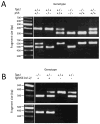Genetic modulation of apoptotic pathways fails to alter disease course in tripeptidyl-peptidase 1 deficient mice
- PMID: 19429009
- PMCID: PMC2680787
- DOI: 10.1016/j.neulet.2009.01.072
Genetic modulation of apoptotic pathways fails to alter disease course in tripeptidyl-peptidase 1 deficient mice
Abstract
Late-infantile neuronal ceroid lipofuscinosis (LINCL) is a fatal, incurable neurodegenerative disease of children caused by the loss of the lysosomal protein tripeptidyl-peptidase 1 (TPP1). Previous studies have suggested that Bcl-2-dependent apoptotic pathways are involved in neuronal cell death in LINCL patients and, as a result, anti-apoptotic treatments that increase Bcl-2 activity have been proposed as a potential therapeutic approach. In this study, we have directly investigated whether targeting anti-apoptotic pathways may be of value in LINCL in a mouse model of this disease that lacks TPP1 and which recapitulates many aspect of the human disease, including a greatly shortened life-span. Our approach was to genetically modify apoptotic pathways and determine the effects of these changes on the severe neurodegenerative phenotype of the LINCL mouse. LINCL mice were generated that either lacked the pro-apoptotic p53 or had increased levels of anti-apoptotic Bcl-2, changes that would exacerbate or ameliorate neuronal death, respectively, should pathways involving these proteins be important. Neither modification affected the shortened life-span of the LINCL mouse. These results suggest that either neuronal death in LINCL does not occur via apoptosis or that it occurs via apoptotic pathways not involving p53 or Bcl-2. Alternatively, pathways involving p53 and/or Bcl-2 may be involved in neuronal death under normal circumstances but may not be the only routes to this end. Importantly, our findings suggest that targeting pathways of cell death involving p53 or Bcl-2 do not represent useful directions for developing effective treatment.
Figures


References
-
- Cooper JD, Russell C, Mitchison HM. Progress towards understanding disease mechanisms in small vertebrate models of neuronal ceroid lipofuscinosis. Biochim Biophys Acta. 2006;1762:873–889. - PubMed
-
- Dhar S, Bitting RL, Rylova SN, Jansen PJ, Lockhart E, Koeberl DD, Amalfitano A, Boustany RM. Flupirtine blocks apoptosis in batten patient lymphoblasts and in human postmitotic CLN3- and CLN2-deficient neurons. Ann Neurol. 2002;51:448–466. - PubMed
-
- Donehower LA, Harvey M, Slagle BL, McArthur MJ, Montgomery CA, Jr, Butel JS, Bradley A. Mice deficient for p53 are developmentally normal but susceptible to spontaneous tumours. Nature. 1992;356:215–221. - PubMed
-
- Engidawork E, Gulesserian T, Seidl R, Cairns N, Lubec G. Expression of apoptosis related proteins in brains of patients with Alzheimer’s disease. Neurosci Lett. 2001;303:79–82. - PubMed
Publication types
MeSH terms
Substances
Grants and funding
LinkOut - more resources
Full Text Sources
Molecular Biology Databases
Research Materials
Miscellaneous

